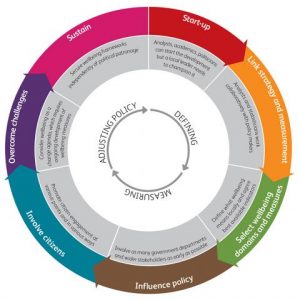Weaving wellbeing into government policy making is no easy task. Rebekah Menzies from Carnegie UK Trust describes how they and Organisation for Economic Co-operation and Development (OECD) have developed straightforward guidance on developing wellbeing frameworks for cities and regions.
By Rebekah Menzies, Carnegie UK Trust
Wellbeing – including social, environmental, economic and democratic wellbeing – should be a key focus of governments at all levels. The Carnegie UK Trust has actively supported governments across the UK to develop wellbeing frameworks to guide policy making. Most recently, the Trust has supported the Northern Ireland Executive to place wellbeing at the heart of its work through the new Programme for Government.
But wellbeing approaches shouldn’t be restricted to a jurisdictional level. The OECD describes wellbeing as ‘a description of social progress in terms of improvements in quality of life, material conditions and sustainability’ (OECD, How’s Life?). While policies at jurisdictional levels are important for these factors, individual wellbeing is also shaped at a very localised level. The Carnegie UK Trust recognises this through our work on Flourishing Towns. Where we live – the very streets and neighbourhoods – matter and have an impact on our wellbeing.
In this regard, city and regional-level governments have an important role to play in promoting wellbeing. Given the dominant focus on jurisdictional level approaches to developing wellbeing frameworks, governments at city and regional levels face particular challenges in establishing and using wellbeing frameworks.
The OECD and Carnegie UK Trust have recognised this challenge, and come together to develop straightforward guidance for decision makers in regional and sub-regional governments on the benefits, challenges and possibilities of using wellbeing frameworks in policy making. The guidance includes evidence from 16 case studies across the OECD, including regions and cities in North America, Europe and Australia that are developing and using wellbeing strategies, objectives and measures.
The guidance outlines the common steps that cities and regions across the world have taken in developing wellbeing frameworks, beginning with the process to kick-start a conversation around a wellbeing framework, to sustaining the framework over the long term.
The process is an ongoing one, involving multiple iterations and refinements, and enduring leadership by local leaders. While leadership from the top is important, so too is continuous communication with and engagement from citizens. Meaningful citizen engagement is important to ensure community by-in to the wellbeing framework. The guidance includes interesting examples of cities and regions that have used wellbeing to bring data collection, policy and community priorities closer together.
The use of wellbeing frameworks, at all levels of government and across the world, is still in its infancy. However, we know that implementing a wellbeing framework can have a transformative effect on governance, allowing for greater transparency and accountability, and more joined-up working and public sector reform.
We suspect that there are more people and organisations out there using wellbeing approaches to shape their work. The next stage of the project is to gather further evidence from around the globe on using wellbeing in policy and practice at all levels – community, local government, neighbourhoods, cities and regions. We have established a crowdsourcing system to collect international examples. Our hope is that we will uncover examples of innovation, which we will share. Help us build a bank of good practice examples, and submit your wellbeing framework here.
You can find out more about the work of Carnegie UK Trust here and the work of the Organisation for Economic Co-operation and Development (OECD) here.

